Comparing and Contrasting Sustainability Reporting of Barclays and AstraZeneca
VerifiedAdded on 2023/01/06
|11
|2958
|60
AI Summary
This report analyzes and evaluates the sustainability reporting of Barclays and AstraZeneca, comparing and contrasting their engagement techniques, verifiability of reports, measurement of social/environmental performance, and best practices in sustainability reporting.
Contribute Materials
Your contribution can guide someone’s learning journey. Share your
documents today.
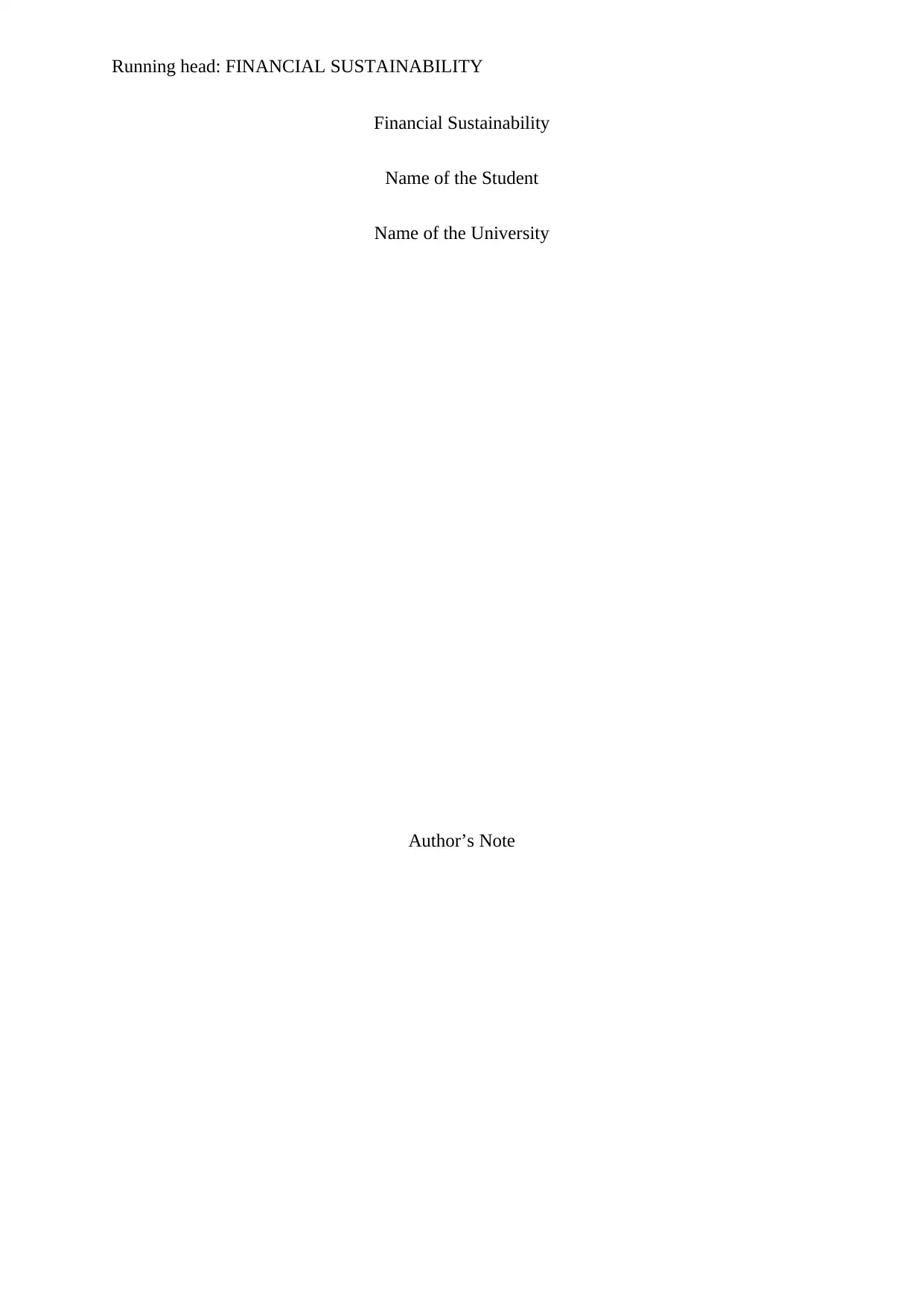
Running head: FINANCIAL SUSTAINABILITY
Financial Sustainability
Name of the Student
Name of the University
Author’s Note
Financial Sustainability
Name of the Student
Name of the University
Author’s Note
Secure Best Marks with AI Grader
Need help grading? Try our AI Grader for instant feedback on your assignments.
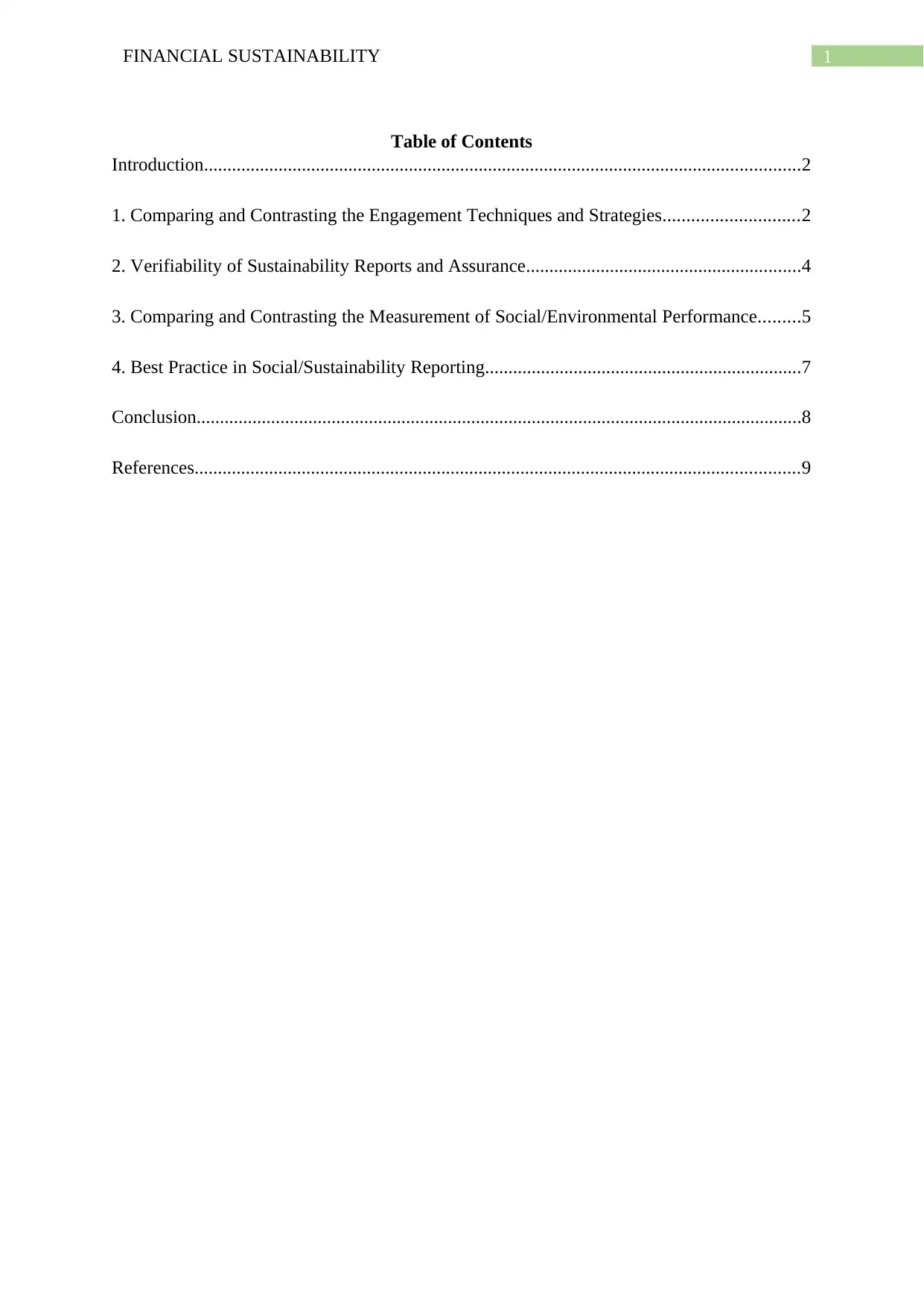
1FINANCIAL SUSTAINABILITY
Table of Contents
Introduction................................................................................................................................2
1. Comparing and Contrasting the Engagement Techniques and Strategies.............................2
2. Verifiability of Sustainability Reports and Assurance...........................................................4
3. Comparing and Contrasting the Measurement of Social/Environmental Performance.........5
4. Best Practice in Social/Sustainability Reporting....................................................................7
Conclusion..................................................................................................................................8
References..................................................................................................................................9
Table of Contents
Introduction................................................................................................................................2
1. Comparing and Contrasting the Engagement Techniques and Strategies.............................2
2. Verifiability of Sustainability Reports and Assurance...........................................................4
3. Comparing and Contrasting the Measurement of Social/Environmental Performance.........5
4. Best Practice in Social/Sustainability Reporting....................................................................7
Conclusion..................................................................................................................................8
References..................................................................................................................................9
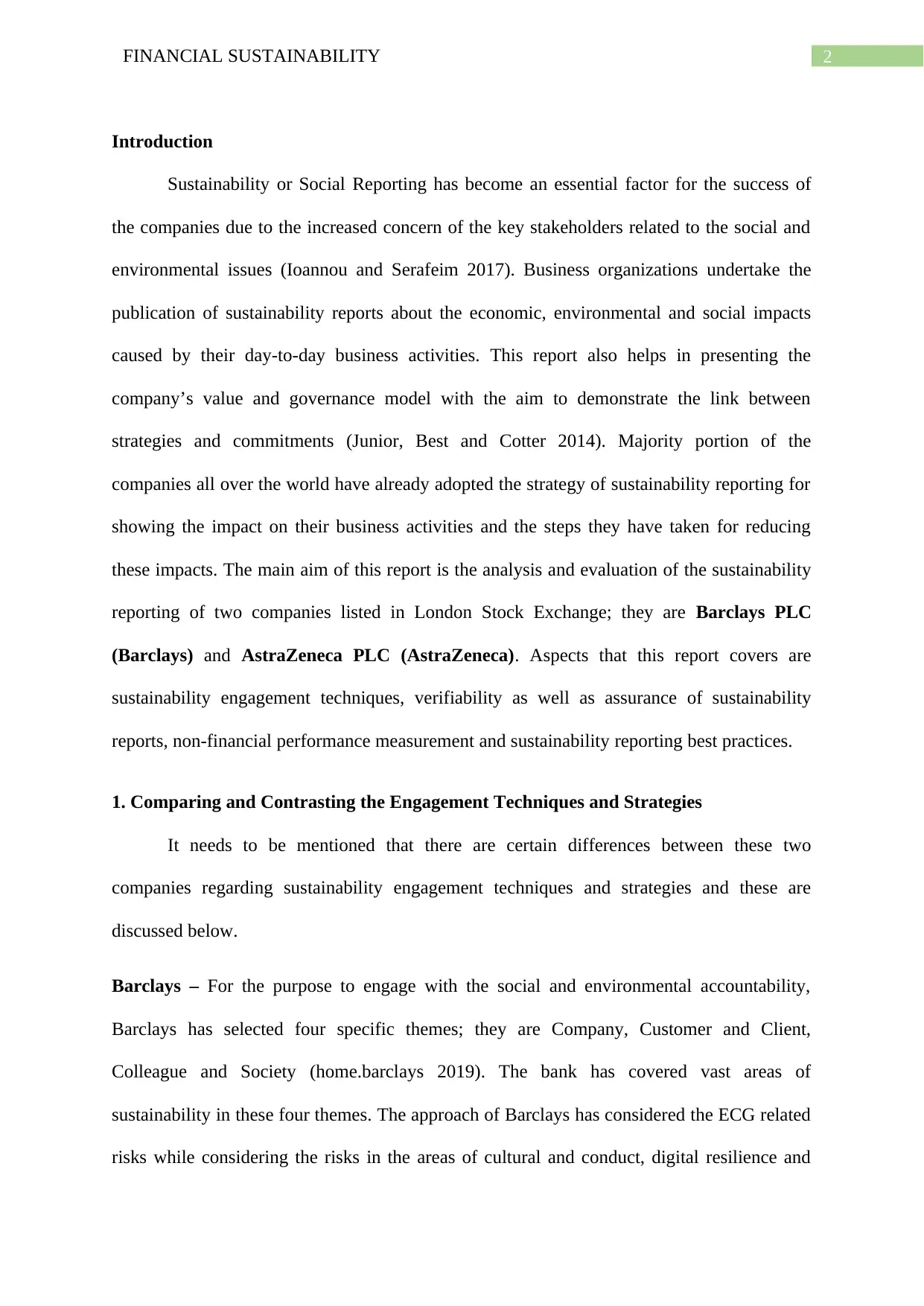
2FINANCIAL SUSTAINABILITY
Introduction
Sustainability or Social Reporting has become an essential factor for the success of
the companies due to the increased concern of the key stakeholders related to the social and
environmental issues (Ioannou and Serafeim 2017). Business organizations undertake the
publication of sustainability reports about the economic, environmental and social impacts
caused by their day-to-day business activities. This report also helps in presenting the
company’s value and governance model with the aim to demonstrate the link between
strategies and commitments (Junior, Best and Cotter 2014). Majority portion of the
companies all over the world have already adopted the strategy of sustainability reporting for
showing the impact on their business activities and the steps they have taken for reducing
these impacts. The main aim of this report is the analysis and evaluation of the sustainability
reporting of two companies listed in London Stock Exchange; they are Barclays PLC
(Barclays) and AstraZeneca PLC (AstraZeneca). Aspects that this report covers are
sustainability engagement techniques, verifiability as well as assurance of sustainability
reports, non-financial performance measurement and sustainability reporting best practices.
1. Comparing and Contrasting the Engagement Techniques and Strategies
It needs to be mentioned that there are certain differences between these two
companies regarding sustainability engagement techniques and strategies and these are
discussed below.
Barclays – For the purpose to engage with the social and environmental accountability,
Barclays has selected four specific themes; they are Company, Customer and Client,
Colleague and Society (home.barclays 2019). The bank has covered vast areas of
sustainability in these four themes. The approach of Barclays has considered the ECG related
risks while considering the risks in the areas of cultural and conduct, digital resilience and
Introduction
Sustainability or Social Reporting has become an essential factor for the success of
the companies due to the increased concern of the key stakeholders related to the social and
environmental issues (Ioannou and Serafeim 2017). Business organizations undertake the
publication of sustainability reports about the economic, environmental and social impacts
caused by their day-to-day business activities. This report also helps in presenting the
company’s value and governance model with the aim to demonstrate the link between
strategies and commitments (Junior, Best and Cotter 2014). Majority portion of the
companies all over the world have already adopted the strategy of sustainability reporting for
showing the impact on their business activities and the steps they have taken for reducing
these impacts. The main aim of this report is the analysis and evaluation of the sustainability
reporting of two companies listed in London Stock Exchange; they are Barclays PLC
(Barclays) and AstraZeneca PLC (AstraZeneca). Aspects that this report covers are
sustainability engagement techniques, verifiability as well as assurance of sustainability
reports, non-financial performance measurement and sustainability reporting best practices.
1. Comparing and Contrasting the Engagement Techniques and Strategies
It needs to be mentioned that there are certain differences between these two
companies regarding sustainability engagement techniques and strategies and these are
discussed below.
Barclays – For the purpose to engage with the social and environmental accountability,
Barclays has selected four specific themes; they are Company, Customer and Client,
Colleague and Society (home.barclays 2019). The bank has covered vast areas of
sustainability in these four themes. The approach of Barclays has considered the ECG related
risks while considering the risks in the areas of cultural and conduct, digital resilience and
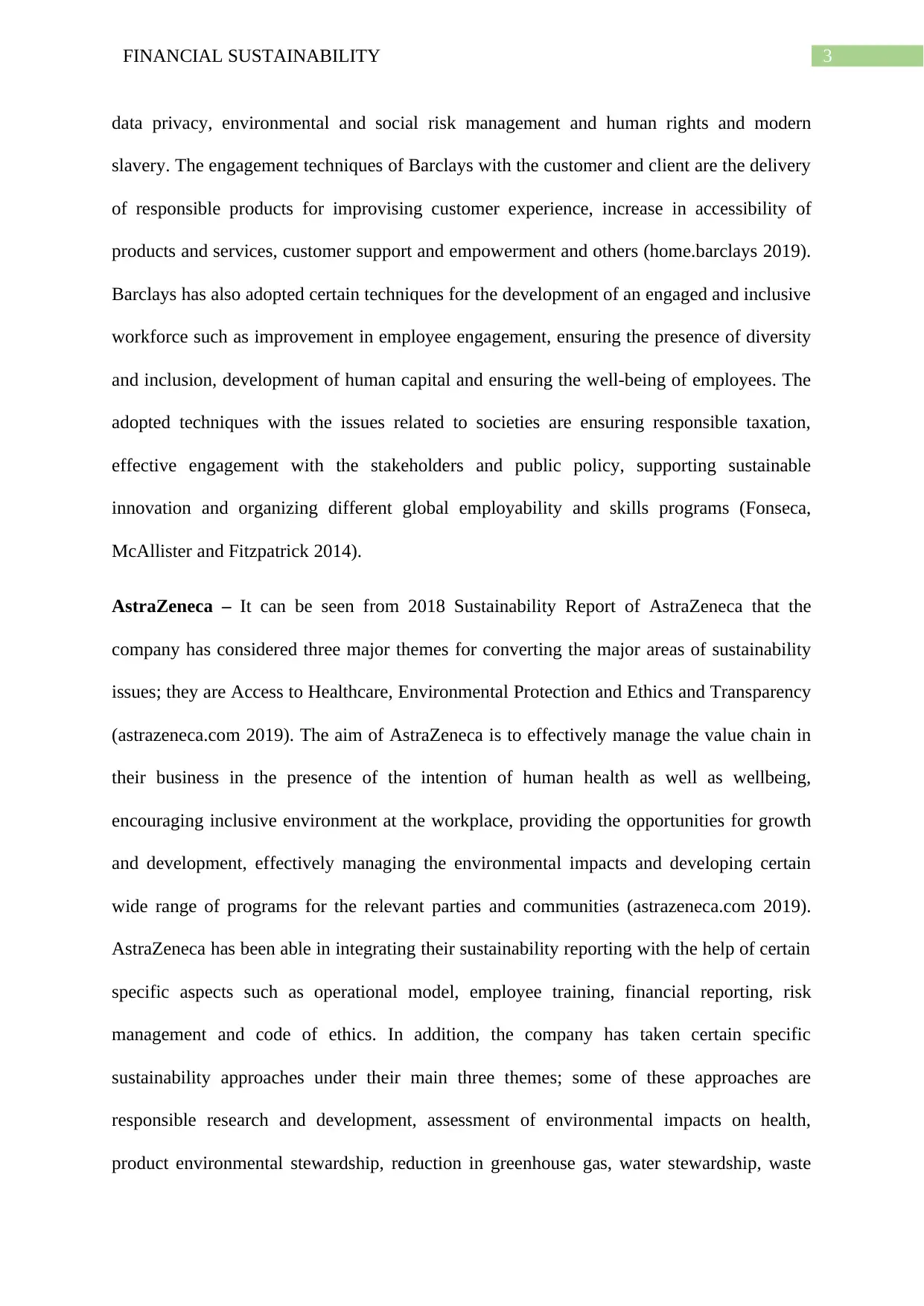
3FINANCIAL SUSTAINABILITY
data privacy, environmental and social risk management and human rights and modern
slavery. The engagement techniques of Barclays with the customer and client are the delivery
of responsible products for improvising customer experience, increase in accessibility of
products and services, customer support and empowerment and others (home.barclays 2019).
Barclays has also adopted certain techniques for the development of an engaged and inclusive
workforce such as improvement in employee engagement, ensuring the presence of diversity
and inclusion, development of human capital and ensuring the well-being of employees. The
adopted techniques with the issues related to societies are ensuring responsible taxation,
effective engagement with the stakeholders and public policy, supporting sustainable
innovation and organizing different global employability and skills programs (Fonseca,
McAllister and Fitzpatrick 2014).
AstraZeneca – It can be seen from 2018 Sustainability Report of AstraZeneca that the
company has considered three major themes for converting the major areas of sustainability
issues; they are Access to Healthcare, Environmental Protection and Ethics and Transparency
(astrazeneca.com 2019). The aim of AstraZeneca is to effectively manage the value chain in
their business in the presence of the intention of human health as well as wellbeing,
encouraging inclusive environment at the workplace, providing the opportunities for growth
and development, effectively managing the environmental impacts and developing certain
wide range of programs for the relevant parties and communities (astrazeneca.com 2019).
AstraZeneca has been able in integrating their sustainability reporting with the help of certain
specific aspects such as operational model, employee training, financial reporting, risk
management and code of ethics. In addition, the company has taken certain specific
sustainability approaches under their main three themes; some of these approaches are
responsible research and development, assessment of environmental impacts on health,
product environmental stewardship, reduction in greenhouse gas, water stewardship, waste
data privacy, environmental and social risk management and human rights and modern
slavery. The engagement techniques of Barclays with the customer and client are the delivery
of responsible products for improvising customer experience, increase in accessibility of
products and services, customer support and empowerment and others (home.barclays 2019).
Barclays has also adopted certain techniques for the development of an engaged and inclusive
workforce such as improvement in employee engagement, ensuring the presence of diversity
and inclusion, development of human capital and ensuring the well-being of employees. The
adopted techniques with the issues related to societies are ensuring responsible taxation,
effective engagement with the stakeholders and public policy, supporting sustainable
innovation and organizing different global employability and skills programs (Fonseca,
McAllister and Fitzpatrick 2014).
AstraZeneca – It can be seen from 2018 Sustainability Report of AstraZeneca that the
company has considered three major themes for converting the major areas of sustainability
issues; they are Access to Healthcare, Environmental Protection and Ethics and Transparency
(astrazeneca.com 2019). The aim of AstraZeneca is to effectively manage the value chain in
their business in the presence of the intention of human health as well as wellbeing,
encouraging inclusive environment at the workplace, providing the opportunities for growth
and development, effectively managing the environmental impacts and developing certain
wide range of programs for the relevant parties and communities (astrazeneca.com 2019).
AstraZeneca has been able in integrating their sustainability reporting with the help of certain
specific aspects such as operational model, employee training, financial reporting, risk
management and code of ethics. In addition, the company has taken certain specific
sustainability approaches under their main three themes; some of these approaches are
responsible research and development, assessment of environmental impacts on health,
product environmental stewardship, reduction in greenhouse gas, water stewardship, waste
Secure Best Marks with AI Grader
Need help grading? Try our AI Grader for instant feedback on your assignments.
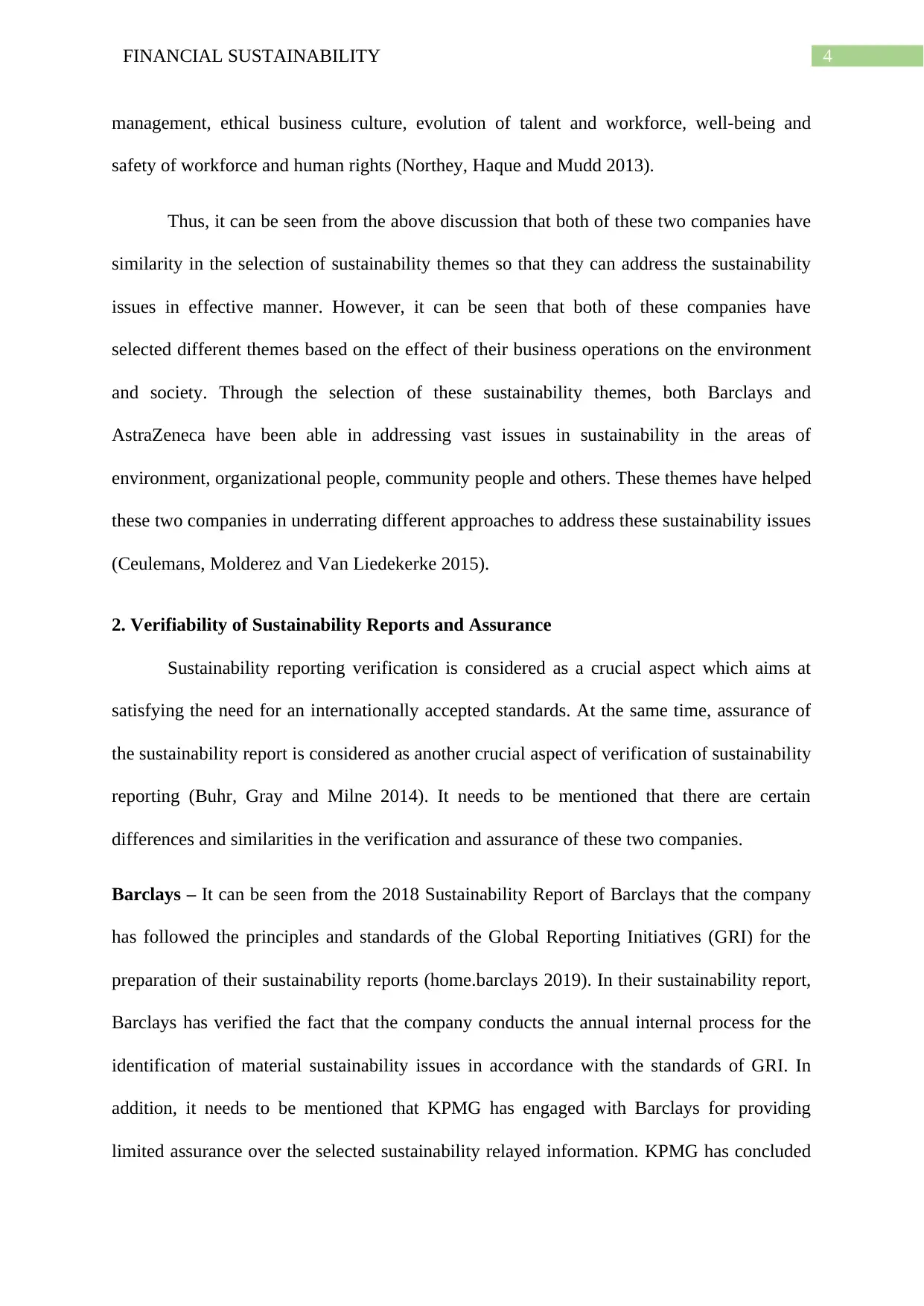
4FINANCIAL SUSTAINABILITY
management, ethical business culture, evolution of talent and workforce, well-being and
safety of workforce and human rights (Northey, Haque and Mudd 2013).
Thus, it can be seen from the above discussion that both of these two companies have
similarity in the selection of sustainability themes so that they can address the sustainability
issues in effective manner. However, it can be seen that both of these companies have
selected different themes based on the effect of their business operations on the environment
and society. Through the selection of these sustainability themes, both Barclays and
AstraZeneca have been able in addressing vast issues in sustainability in the areas of
environment, organizational people, community people and others. These themes have helped
these two companies in underrating different approaches to address these sustainability issues
(Ceulemans, Molderez and Van Liedekerke 2015).
2. Verifiability of Sustainability Reports and Assurance
Sustainability reporting verification is considered as a crucial aspect which aims at
satisfying the need for an internationally accepted standards. At the same time, assurance of
the sustainability report is considered as another crucial aspect of verification of sustainability
reporting (Buhr, Gray and Milne 2014). It needs to be mentioned that there are certain
differences and similarities in the verification and assurance of these two companies.
Barclays – It can be seen from the 2018 Sustainability Report of Barclays that the company
has followed the principles and standards of the Global Reporting Initiatives (GRI) for the
preparation of their sustainability reports (home.barclays 2019). In their sustainability report,
Barclays has verified the fact that the company conducts the annual internal process for the
identification of material sustainability issues in accordance with the standards of GRI. In
addition, it needs to be mentioned that KPMG has engaged with Barclays for providing
limited assurance over the selected sustainability relayed information. KPMG has concluded
management, ethical business culture, evolution of talent and workforce, well-being and
safety of workforce and human rights (Northey, Haque and Mudd 2013).
Thus, it can be seen from the above discussion that both of these two companies have
similarity in the selection of sustainability themes so that they can address the sustainability
issues in effective manner. However, it can be seen that both of these companies have
selected different themes based on the effect of their business operations on the environment
and society. Through the selection of these sustainability themes, both Barclays and
AstraZeneca have been able in addressing vast issues in sustainability in the areas of
environment, organizational people, community people and others. These themes have helped
these two companies in underrating different approaches to address these sustainability issues
(Ceulemans, Molderez and Van Liedekerke 2015).
2. Verifiability of Sustainability Reports and Assurance
Sustainability reporting verification is considered as a crucial aspect which aims at
satisfying the need for an internationally accepted standards. At the same time, assurance of
the sustainability report is considered as another crucial aspect of verification of sustainability
reporting (Buhr, Gray and Milne 2014). It needs to be mentioned that there are certain
differences and similarities in the verification and assurance of these two companies.
Barclays – It can be seen from the 2018 Sustainability Report of Barclays that the company
has followed the principles and standards of the Global Reporting Initiatives (GRI) for the
preparation of their sustainability reports (home.barclays 2019). In their sustainability report,
Barclays has verified the fact that the company conducts the annual internal process for the
identification of material sustainability issues in accordance with the standards of GRI. In
addition, it needs to be mentioned that KPMG has engaged with Barclays for providing
limited assurance over the selected sustainability relayed information. KPMG has concluded
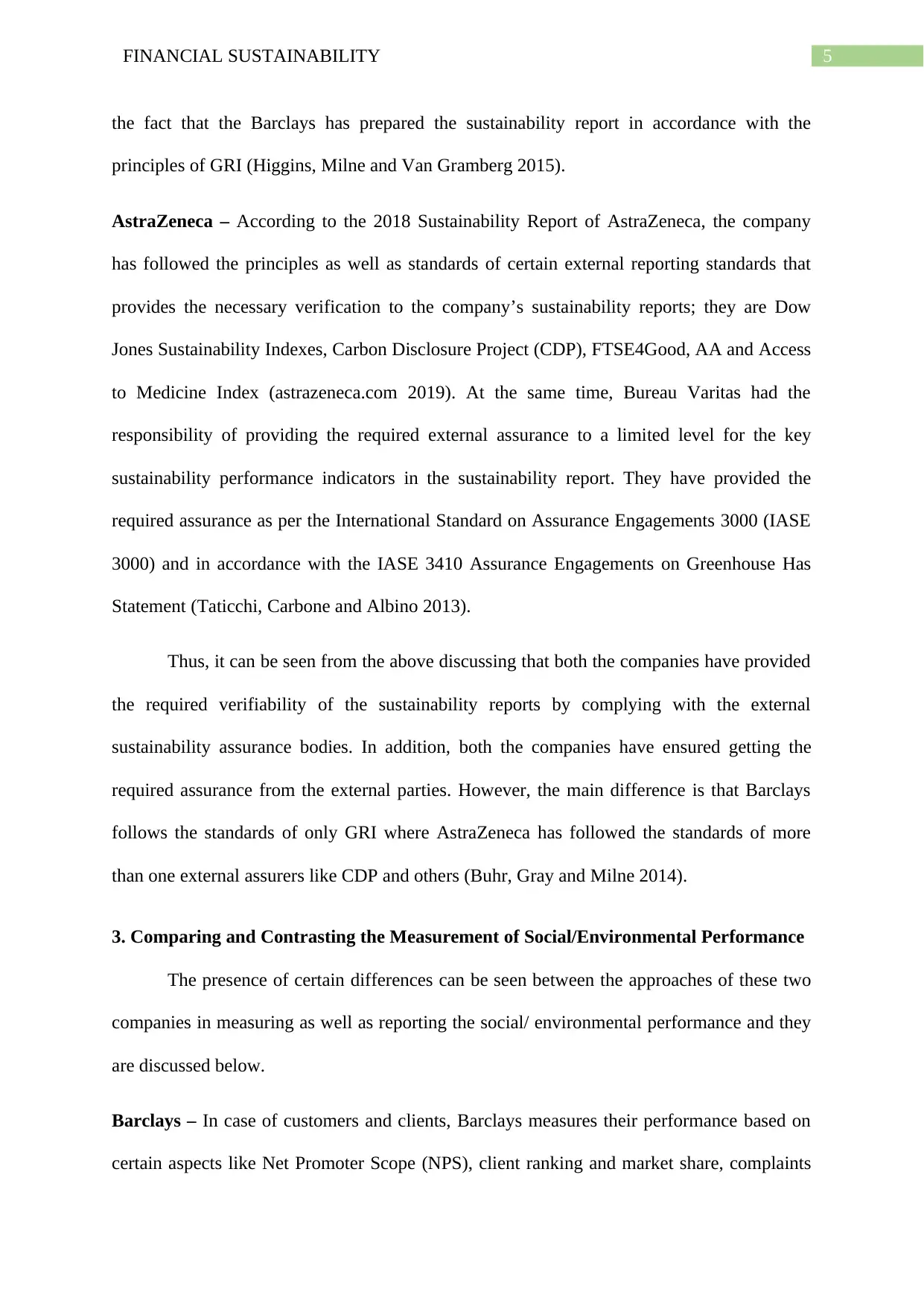
5FINANCIAL SUSTAINABILITY
the fact that the Barclays has prepared the sustainability report in accordance with the
principles of GRI (Higgins, Milne and Van Gramberg 2015).
AstraZeneca – According to the 2018 Sustainability Report of AstraZeneca, the company
has followed the principles as well as standards of certain external reporting standards that
provides the necessary verification to the company’s sustainability reports; they are Dow
Jones Sustainability Indexes, Carbon Disclosure Project (CDP), FTSE4Good, AA and Access
to Medicine Index (astrazeneca.com 2019). At the same time, Bureau Varitas had the
responsibility of providing the required external assurance to a limited level for the key
sustainability performance indicators in the sustainability report. They have provided the
required assurance as per the International Standard on Assurance Engagements 3000 (IASE
3000) and in accordance with the IASE 3410 Assurance Engagements on Greenhouse Has
Statement (Taticchi, Carbone and Albino 2013).
Thus, it can be seen from the above discussing that both the companies have provided
the required verifiability of the sustainability reports by complying with the external
sustainability assurance bodies. In addition, both the companies have ensured getting the
required assurance from the external parties. However, the main difference is that Barclays
follows the standards of only GRI where AstraZeneca has followed the standards of more
than one external assurers like CDP and others (Buhr, Gray and Milne 2014).
3. Comparing and Contrasting the Measurement of Social/Environmental Performance
The presence of certain differences can be seen between the approaches of these two
companies in measuring as well as reporting the social/ environmental performance and they
are discussed below.
Barclays – In case of customers and clients, Barclays measures their performance based on
certain aspects like Net Promoter Scope (NPS), client ranking and market share, complaints
the fact that the Barclays has prepared the sustainability report in accordance with the
principles of GRI (Higgins, Milne and Van Gramberg 2015).
AstraZeneca – According to the 2018 Sustainability Report of AstraZeneca, the company
has followed the principles as well as standards of certain external reporting standards that
provides the necessary verification to the company’s sustainability reports; they are Dow
Jones Sustainability Indexes, Carbon Disclosure Project (CDP), FTSE4Good, AA and Access
to Medicine Index (astrazeneca.com 2019). At the same time, Bureau Varitas had the
responsibility of providing the required external assurance to a limited level for the key
sustainability performance indicators in the sustainability report. They have provided the
required assurance as per the International Standard on Assurance Engagements 3000 (IASE
3000) and in accordance with the IASE 3410 Assurance Engagements on Greenhouse Has
Statement (Taticchi, Carbone and Albino 2013).
Thus, it can be seen from the above discussing that both the companies have provided
the required verifiability of the sustainability reports by complying with the external
sustainability assurance bodies. In addition, both the companies have ensured getting the
required assurance from the external parties. However, the main difference is that Barclays
follows the standards of only GRI where AstraZeneca has followed the standards of more
than one external assurers like CDP and others (Buhr, Gray and Milne 2014).
3. Comparing and Contrasting the Measurement of Social/Environmental Performance
The presence of certain differences can be seen between the approaches of these two
companies in measuring as well as reporting the social/ environmental performance and they
are discussed below.
Barclays – In case of customers and clients, Barclays measures their performance based on
certain aspects like Net Promoter Scope (NPS), client ranking and market share, complaints
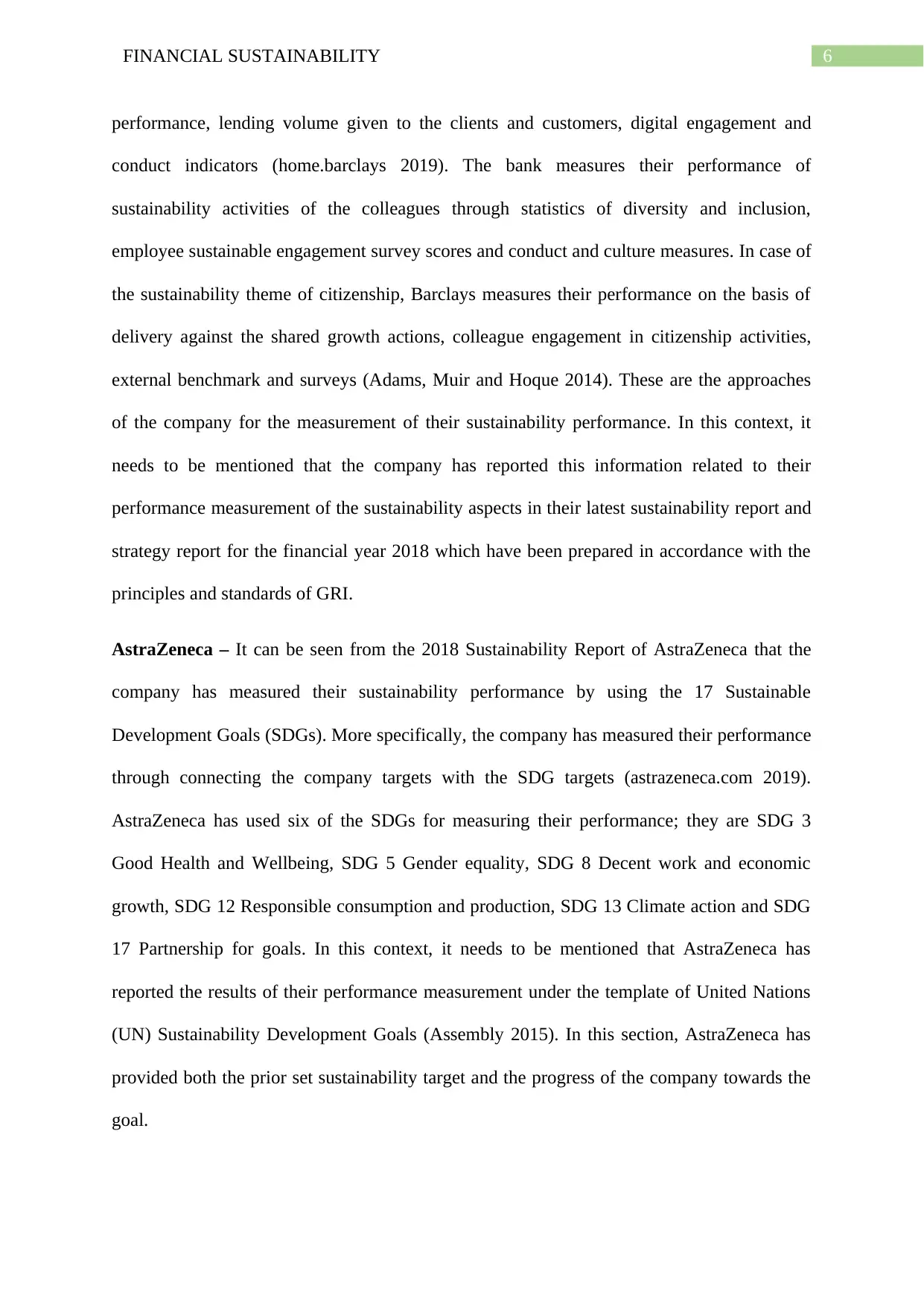
6FINANCIAL SUSTAINABILITY
performance, lending volume given to the clients and customers, digital engagement and
conduct indicators (home.barclays 2019). The bank measures their performance of
sustainability activities of the colleagues through statistics of diversity and inclusion,
employee sustainable engagement survey scores and conduct and culture measures. In case of
the sustainability theme of citizenship, Barclays measures their performance on the basis of
delivery against the shared growth actions, colleague engagement in citizenship activities,
external benchmark and surveys (Adams, Muir and Hoque 2014). These are the approaches
of the company for the measurement of their sustainability performance. In this context, it
needs to be mentioned that the company has reported this information related to their
performance measurement of the sustainability aspects in their latest sustainability report and
strategy report for the financial year 2018 which have been prepared in accordance with the
principles and standards of GRI.
AstraZeneca – It can be seen from the 2018 Sustainability Report of AstraZeneca that the
company has measured their sustainability performance by using the 17 Sustainable
Development Goals (SDGs). More specifically, the company has measured their performance
through connecting the company targets with the SDG targets (astrazeneca.com 2019).
AstraZeneca has used six of the SDGs for measuring their performance; they are SDG 3
Good Health and Wellbeing, SDG 5 Gender equality, SDG 8 Decent work and economic
growth, SDG 12 Responsible consumption and production, SDG 13 Climate action and SDG
17 Partnership for goals. In this context, it needs to be mentioned that AstraZeneca has
reported the results of their performance measurement under the template of United Nations
(UN) Sustainability Development Goals (Assembly 2015). In this section, AstraZeneca has
provided both the prior set sustainability target and the progress of the company towards the
goal.
performance, lending volume given to the clients and customers, digital engagement and
conduct indicators (home.barclays 2019). The bank measures their performance of
sustainability activities of the colleagues through statistics of diversity and inclusion,
employee sustainable engagement survey scores and conduct and culture measures. In case of
the sustainability theme of citizenship, Barclays measures their performance on the basis of
delivery against the shared growth actions, colleague engagement in citizenship activities,
external benchmark and surveys (Adams, Muir and Hoque 2014). These are the approaches
of the company for the measurement of their sustainability performance. In this context, it
needs to be mentioned that the company has reported this information related to their
performance measurement of the sustainability aspects in their latest sustainability report and
strategy report for the financial year 2018 which have been prepared in accordance with the
principles and standards of GRI.
AstraZeneca – It can be seen from the 2018 Sustainability Report of AstraZeneca that the
company has measured their sustainability performance by using the 17 Sustainable
Development Goals (SDGs). More specifically, the company has measured their performance
through connecting the company targets with the SDG targets (astrazeneca.com 2019).
AstraZeneca has used six of the SDGs for measuring their performance; they are SDG 3
Good Health and Wellbeing, SDG 5 Gender equality, SDG 8 Decent work and economic
growth, SDG 12 Responsible consumption and production, SDG 13 Climate action and SDG
17 Partnership for goals. In this context, it needs to be mentioned that AstraZeneca has
reported the results of their performance measurement under the template of United Nations
(UN) Sustainability Development Goals (Assembly 2015). In this section, AstraZeneca has
provided both the prior set sustainability target and the progress of the company towards the
goal.
Paraphrase This Document
Need a fresh take? Get an instant paraphrase of this document with our AI Paraphraser
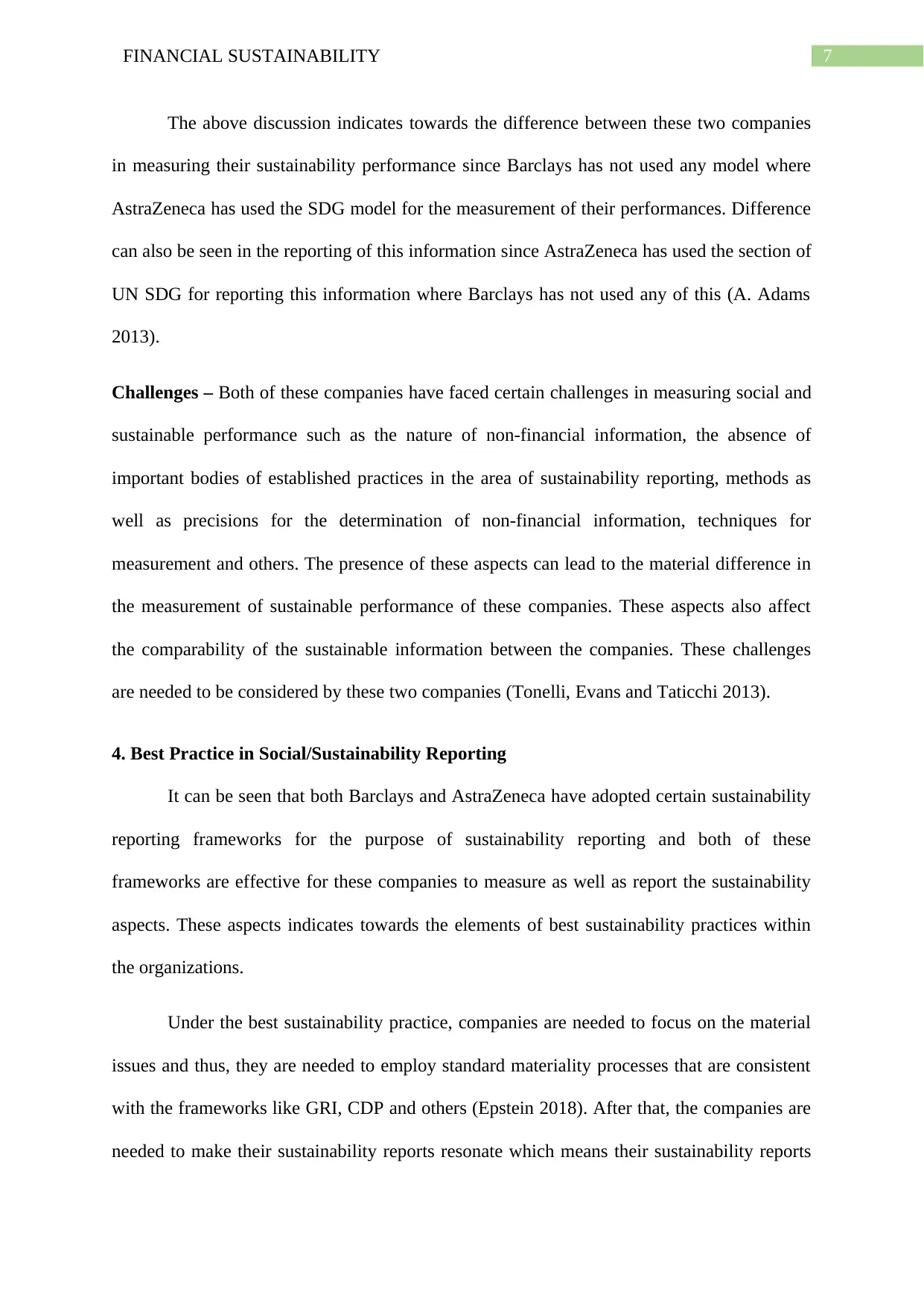
7FINANCIAL SUSTAINABILITY
The above discussion indicates towards the difference between these two companies
in measuring their sustainability performance since Barclays has not used any model where
AstraZeneca has used the SDG model for the measurement of their performances. Difference
can also be seen in the reporting of this information since AstraZeneca has used the section of
UN SDG for reporting this information where Barclays has not used any of this (A. Adams
2013).
Challenges – Both of these companies have faced certain challenges in measuring social and
sustainable performance such as the nature of non-financial information, the absence of
important bodies of established practices in the area of sustainability reporting, methods as
well as precisions for the determination of non-financial information, techniques for
measurement and others. The presence of these aspects can lead to the material difference in
the measurement of sustainable performance of these companies. These aspects also affect
the comparability of the sustainable information between the companies. These challenges
are needed to be considered by these two companies (Tonelli, Evans and Taticchi 2013).
4. Best Practice in Social/Sustainability Reporting
It can be seen that both Barclays and AstraZeneca have adopted certain sustainability
reporting frameworks for the purpose of sustainability reporting and both of these
frameworks are effective for these companies to measure as well as report the sustainability
aspects. These aspects indicates towards the elements of best sustainability practices within
the organizations.
Under the best sustainability practice, companies are needed to focus on the material
issues and thus, they are needed to employ standard materiality processes that are consistent
with the frameworks like GRI, CDP and others (Epstein 2018). After that, the companies are
needed to make their sustainability reports resonate which means their sustainability reports
The above discussion indicates towards the difference between these two companies
in measuring their sustainability performance since Barclays has not used any model where
AstraZeneca has used the SDG model for the measurement of their performances. Difference
can also be seen in the reporting of this information since AstraZeneca has used the section of
UN SDG for reporting this information where Barclays has not used any of this (A. Adams
2013).
Challenges – Both of these companies have faced certain challenges in measuring social and
sustainable performance such as the nature of non-financial information, the absence of
important bodies of established practices in the area of sustainability reporting, methods as
well as precisions for the determination of non-financial information, techniques for
measurement and others. The presence of these aspects can lead to the material difference in
the measurement of sustainable performance of these companies. These aspects also affect
the comparability of the sustainable information between the companies. These challenges
are needed to be considered by these two companies (Tonelli, Evans and Taticchi 2013).
4. Best Practice in Social/Sustainability Reporting
It can be seen that both Barclays and AstraZeneca have adopted certain sustainability
reporting frameworks for the purpose of sustainability reporting and both of these
frameworks are effective for these companies to measure as well as report the sustainability
aspects. These aspects indicates towards the elements of best sustainability practices within
the organizations.
Under the best sustainability practice, companies are needed to focus on the material
issues and thus, they are needed to employ standard materiality processes that are consistent
with the frameworks like GRI, CDP and others (Epstein 2018). After that, the companies are
needed to make their sustainability reports resonate which means their sustainability reports
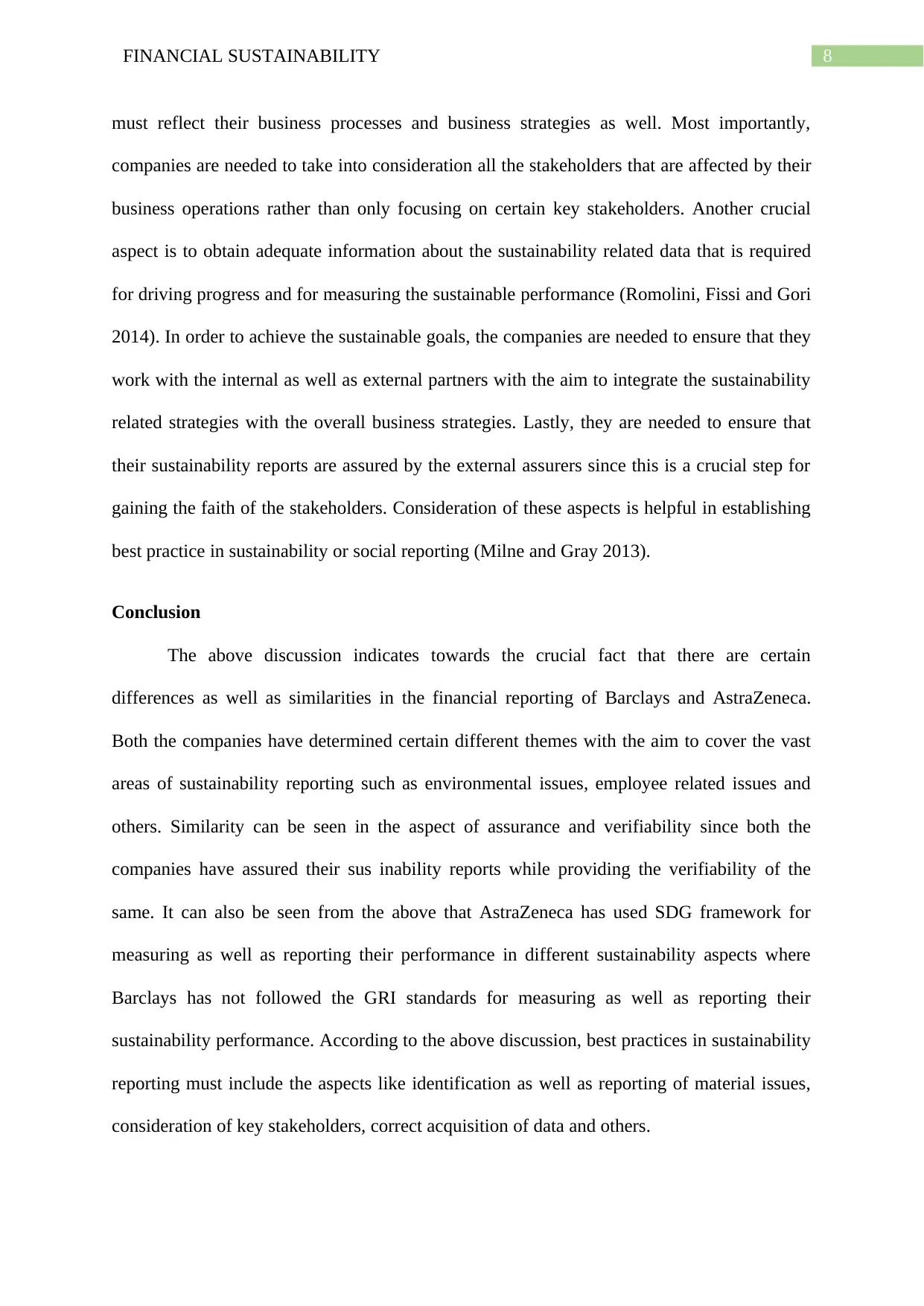
8FINANCIAL SUSTAINABILITY
must reflect their business processes and business strategies as well. Most importantly,
companies are needed to take into consideration all the stakeholders that are affected by their
business operations rather than only focusing on certain key stakeholders. Another crucial
aspect is to obtain adequate information about the sustainability related data that is required
for driving progress and for measuring the sustainable performance (Romolini, Fissi and Gori
2014). In order to achieve the sustainable goals, the companies are needed to ensure that they
work with the internal as well as external partners with the aim to integrate the sustainability
related strategies with the overall business strategies. Lastly, they are needed to ensure that
their sustainability reports are assured by the external assurers since this is a crucial step for
gaining the faith of the stakeholders. Consideration of these aspects is helpful in establishing
best practice in sustainability or social reporting (Milne and Gray 2013).
Conclusion
The above discussion indicates towards the crucial fact that there are certain
differences as well as similarities in the financial reporting of Barclays and AstraZeneca.
Both the companies have determined certain different themes with the aim to cover the vast
areas of sustainability reporting such as environmental issues, employee related issues and
others. Similarity can be seen in the aspect of assurance and verifiability since both the
companies have assured their sus inability reports while providing the verifiability of the
same. It can also be seen from the above that AstraZeneca has used SDG framework for
measuring as well as reporting their performance in different sustainability aspects where
Barclays has not followed the GRI standards for measuring as well as reporting their
sustainability performance. According to the above discussion, best practices in sustainability
reporting must include the aspects like identification as well as reporting of material issues,
consideration of key stakeholders, correct acquisition of data and others.
must reflect their business processes and business strategies as well. Most importantly,
companies are needed to take into consideration all the stakeholders that are affected by their
business operations rather than only focusing on certain key stakeholders. Another crucial
aspect is to obtain adequate information about the sustainability related data that is required
for driving progress and for measuring the sustainable performance (Romolini, Fissi and Gori
2014). In order to achieve the sustainable goals, the companies are needed to ensure that they
work with the internal as well as external partners with the aim to integrate the sustainability
related strategies with the overall business strategies. Lastly, they are needed to ensure that
their sustainability reports are assured by the external assurers since this is a crucial step for
gaining the faith of the stakeholders. Consideration of these aspects is helpful in establishing
best practice in sustainability or social reporting (Milne and Gray 2013).
Conclusion
The above discussion indicates towards the crucial fact that there are certain
differences as well as similarities in the financial reporting of Barclays and AstraZeneca.
Both the companies have determined certain different themes with the aim to cover the vast
areas of sustainability reporting such as environmental issues, employee related issues and
others. Similarity can be seen in the aspect of assurance and verifiability since both the
companies have assured their sus inability reports while providing the verifiability of the
same. It can also be seen from the above that AstraZeneca has used SDG framework for
measuring as well as reporting their performance in different sustainability aspects where
Barclays has not followed the GRI standards for measuring as well as reporting their
sustainability performance. According to the above discussion, best practices in sustainability
reporting must include the aspects like identification as well as reporting of material issues,
consideration of key stakeholders, correct acquisition of data and others.
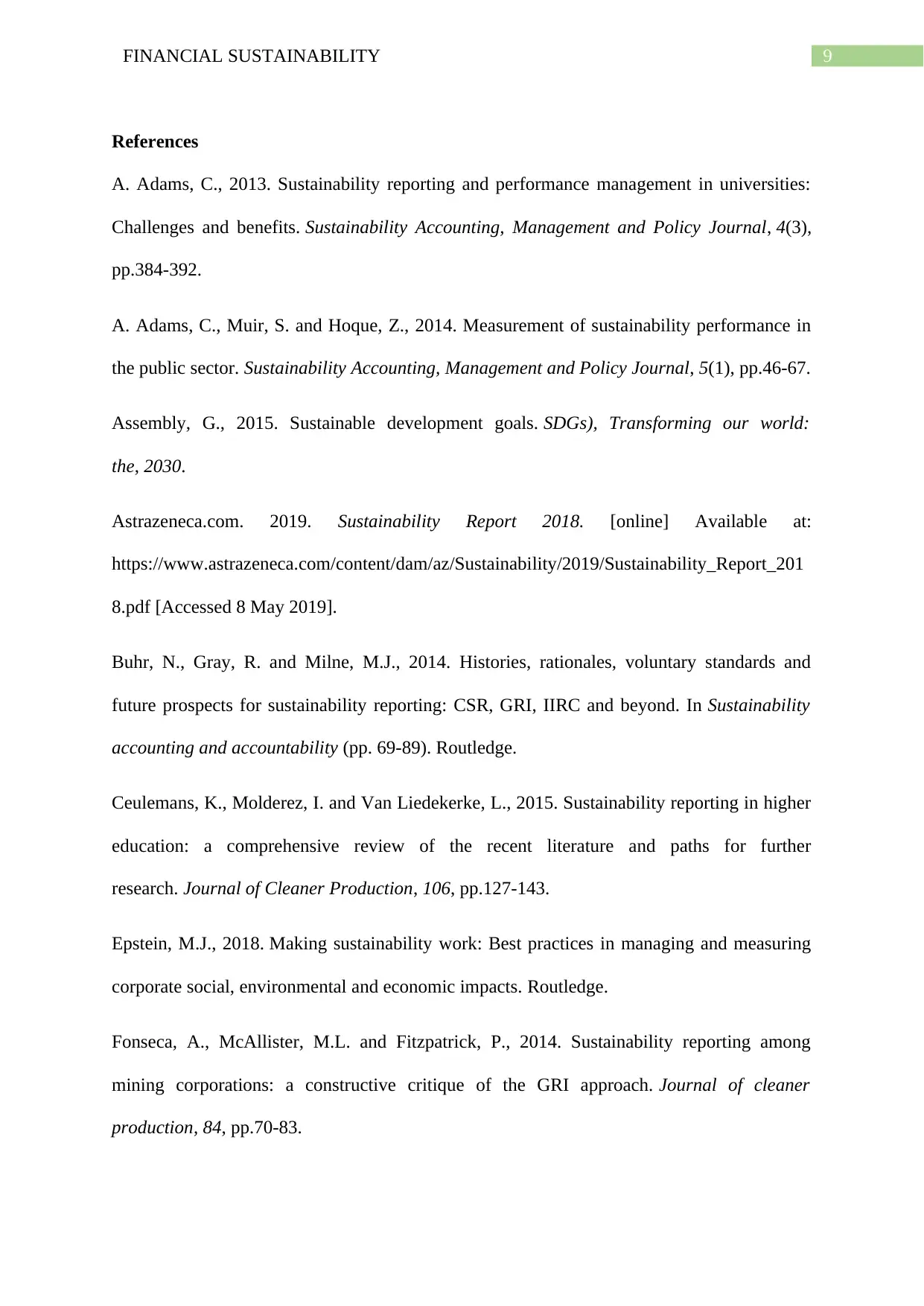
9FINANCIAL SUSTAINABILITY
References
A. Adams, C., 2013. Sustainability reporting and performance management in universities:
Challenges and benefits. Sustainability Accounting, Management and Policy Journal, 4(3),
pp.384-392.
A. Adams, C., Muir, S. and Hoque, Z., 2014. Measurement of sustainability performance in
the public sector. Sustainability Accounting, Management and Policy Journal, 5(1), pp.46-67.
Assembly, G., 2015. Sustainable development goals. SDGs), Transforming our world:
the, 2030.
Astrazeneca.com. 2019. Sustainability Report 2018. [online] Available at:
https://www.astrazeneca.com/content/dam/az/Sustainability/2019/Sustainability_Report_201
8.pdf [Accessed 8 May 2019].
Buhr, N., Gray, R. and Milne, M.J., 2014. Histories, rationales, voluntary standards and
future prospects for sustainability reporting: CSR, GRI, IIRC and beyond. In Sustainability
accounting and accountability (pp. 69-89). Routledge.
Ceulemans, K., Molderez, I. and Van Liedekerke, L., 2015. Sustainability reporting in higher
education: a comprehensive review of the recent literature and paths for further
research. Journal of Cleaner Production, 106, pp.127-143.
Epstein, M.J., 2018. Making sustainability work: Best practices in managing and measuring
corporate social, environmental and economic impacts. Routledge.
Fonseca, A., McAllister, M.L. and Fitzpatrick, P., 2014. Sustainability reporting among
mining corporations: a constructive critique of the GRI approach. Journal of cleaner
production, 84, pp.70-83.
References
A. Adams, C., 2013. Sustainability reporting and performance management in universities:
Challenges and benefits. Sustainability Accounting, Management and Policy Journal, 4(3),
pp.384-392.
A. Adams, C., Muir, S. and Hoque, Z., 2014. Measurement of sustainability performance in
the public sector. Sustainability Accounting, Management and Policy Journal, 5(1), pp.46-67.
Assembly, G., 2015. Sustainable development goals. SDGs), Transforming our world:
the, 2030.
Astrazeneca.com. 2019. Sustainability Report 2018. [online] Available at:
https://www.astrazeneca.com/content/dam/az/Sustainability/2019/Sustainability_Report_201
8.pdf [Accessed 8 May 2019].
Buhr, N., Gray, R. and Milne, M.J., 2014. Histories, rationales, voluntary standards and
future prospects for sustainability reporting: CSR, GRI, IIRC and beyond. In Sustainability
accounting and accountability (pp. 69-89). Routledge.
Ceulemans, K., Molderez, I. and Van Liedekerke, L., 2015. Sustainability reporting in higher
education: a comprehensive review of the recent literature and paths for further
research. Journal of Cleaner Production, 106, pp.127-143.
Epstein, M.J., 2018. Making sustainability work: Best practices in managing and measuring
corporate social, environmental and economic impacts. Routledge.
Fonseca, A., McAllister, M.L. and Fitzpatrick, P., 2014. Sustainability reporting among
mining corporations: a constructive critique of the GRI approach. Journal of cleaner
production, 84, pp.70-83.
Secure Best Marks with AI Grader
Need help grading? Try our AI Grader for instant feedback on your assignments.
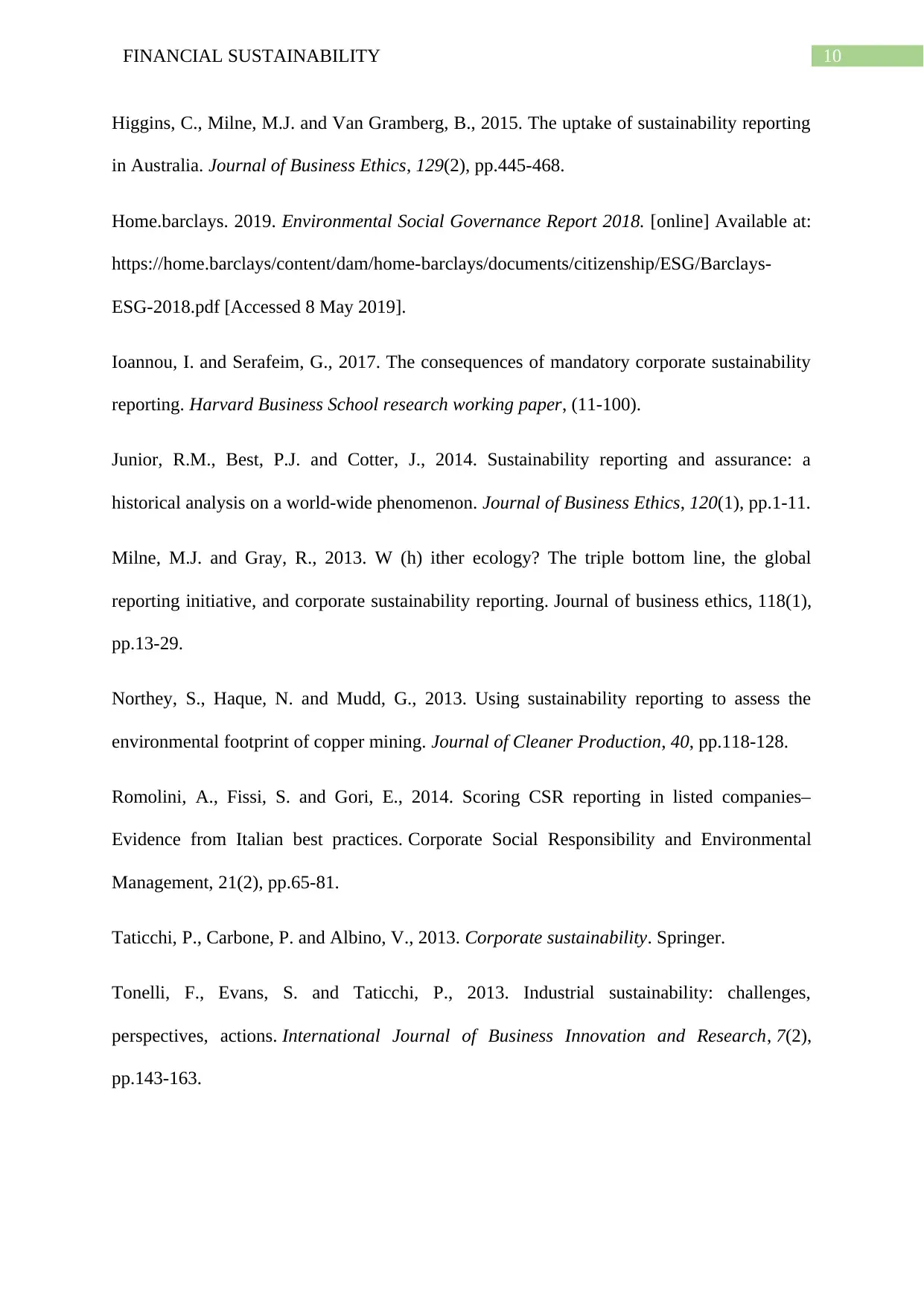
10FINANCIAL SUSTAINABILITY
Higgins, C., Milne, M.J. and Van Gramberg, B., 2015. The uptake of sustainability reporting
in Australia. Journal of Business Ethics, 129(2), pp.445-468.
Home.barclays. 2019. Environmental Social Governance Report 2018. [online] Available at:
https://home.barclays/content/dam/home-barclays/documents/citizenship/ESG/Barclays-
ESG-2018.pdf [Accessed 8 May 2019].
Ioannou, I. and Serafeim, G., 2017. The consequences of mandatory corporate sustainability
reporting. Harvard Business School research working paper, (11-100).
Junior, R.M., Best, P.J. and Cotter, J., 2014. Sustainability reporting and assurance: a
historical analysis on a world-wide phenomenon. Journal of Business Ethics, 120(1), pp.1-11.
Milne, M.J. and Gray, R., 2013. W (h) ither ecology? The triple bottom line, the global
reporting initiative, and corporate sustainability reporting. Journal of business ethics, 118(1),
pp.13-29.
Northey, S., Haque, N. and Mudd, G., 2013. Using sustainability reporting to assess the
environmental footprint of copper mining. Journal of Cleaner Production, 40, pp.118-128.
Romolini, A., Fissi, S. and Gori, E., 2014. Scoring CSR reporting in listed companies–
Evidence from Italian best practices. Corporate Social Responsibility and Environmental
Management, 21(2), pp.65-81.
Taticchi, P., Carbone, P. and Albino, V., 2013. Corporate sustainability. Springer.
Tonelli, F., Evans, S. and Taticchi, P., 2013. Industrial sustainability: challenges,
perspectives, actions. International Journal of Business Innovation and Research, 7(2),
pp.143-163.
Higgins, C., Milne, M.J. and Van Gramberg, B., 2015. The uptake of sustainability reporting
in Australia. Journal of Business Ethics, 129(2), pp.445-468.
Home.barclays. 2019. Environmental Social Governance Report 2018. [online] Available at:
https://home.barclays/content/dam/home-barclays/documents/citizenship/ESG/Barclays-
ESG-2018.pdf [Accessed 8 May 2019].
Ioannou, I. and Serafeim, G., 2017. The consequences of mandatory corporate sustainability
reporting. Harvard Business School research working paper, (11-100).
Junior, R.M., Best, P.J. and Cotter, J., 2014. Sustainability reporting and assurance: a
historical analysis on a world-wide phenomenon. Journal of Business Ethics, 120(1), pp.1-11.
Milne, M.J. and Gray, R., 2013. W (h) ither ecology? The triple bottom line, the global
reporting initiative, and corporate sustainability reporting. Journal of business ethics, 118(1),
pp.13-29.
Northey, S., Haque, N. and Mudd, G., 2013. Using sustainability reporting to assess the
environmental footprint of copper mining. Journal of Cleaner Production, 40, pp.118-128.
Romolini, A., Fissi, S. and Gori, E., 2014. Scoring CSR reporting in listed companies–
Evidence from Italian best practices. Corporate Social Responsibility and Environmental
Management, 21(2), pp.65-81.
Taticchi, P., Carbone, P. and Albino, V., 2013. Corporate sustainability. Springer.
Tonelli, F., Evans, S. and Taticchi, P., 2013. Industrial sustainability: challenges,
perspectives, actions. International Journal of Business Innovation and Research, 7(2),
pp.143-163.
1 out of 11
Related Documents
Your All-in-One AI-Powered Toolkit for Academic Success.
+13062052269
info@desklib.com
Available 24*7 on WhatsApp / Email
![[object Object]](/_next/static/media/star-bottom.7253800d.svg)
Unlock your academic potential
© 2024 | Zucol Services PVT LTD | All rights reserved.





